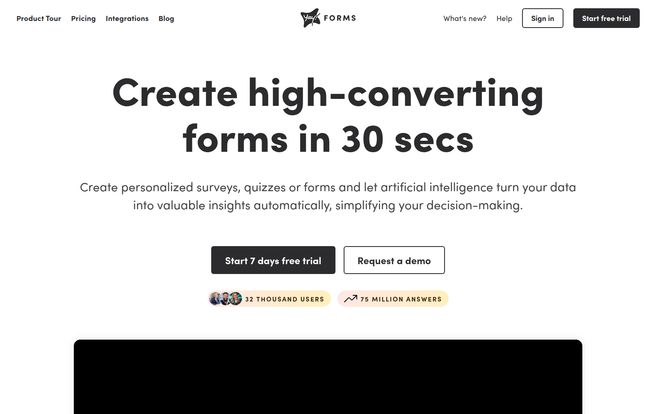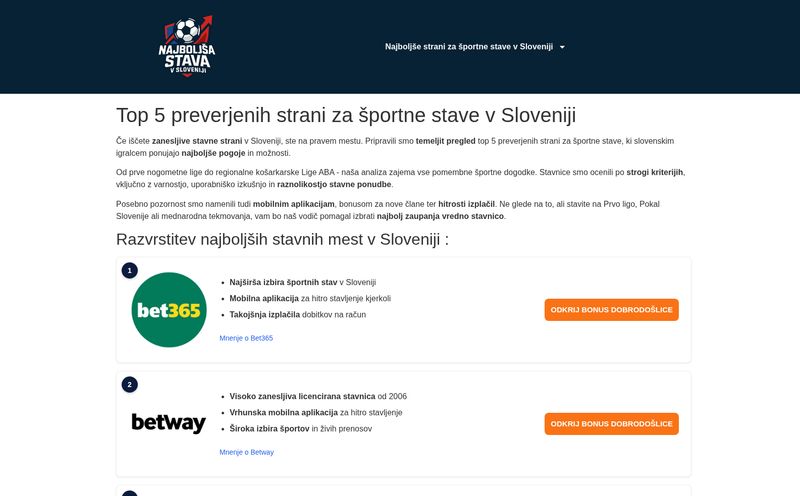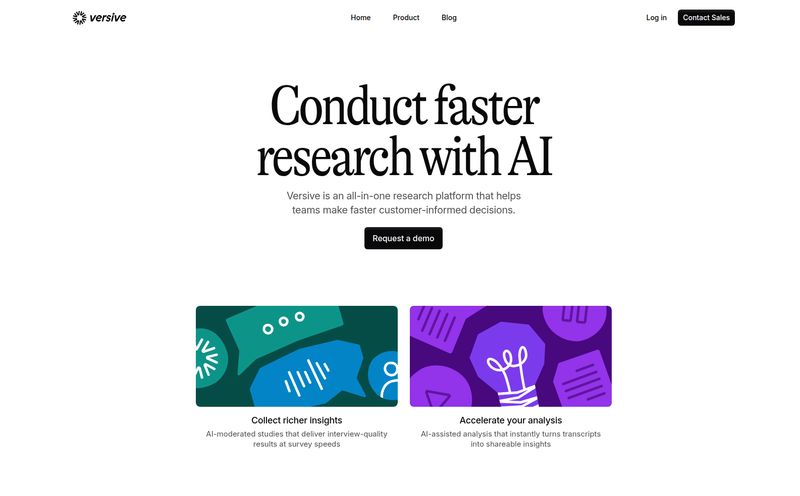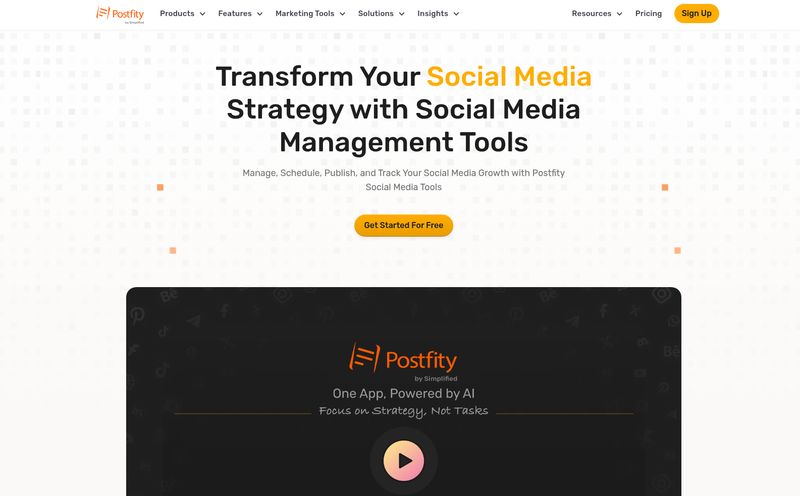As marketers, SEOs, and business owners, we’re obsessed with data. We set up forms, run surveys, and ask for feedback like our lives depend on it. And in a way, they do. But here’s the dirty little secret nobody likes to admit: collecting the data is the easy part. The real soul-crushing work is figuring out what it all means.
I’ve spent more late nights than I care to admit staring at spreadsheets filled with open-ended feedback, trying to manually tag responses, and feeling my brain slowly turn to mush. You collect 500 responses to a customer satisfaction survey, and you’re faced with a wall of text. It's a classic case of "information overload." So when I first heard about Yay! Forms, a tool that claims to use AI to do the heavy lifting for you, my inner cynic immediately piped up. Another form builder?
But this one felt a little different. It wasn’t just about pretty forms; it was about the intelligence behind them. So, I decided to take it for a spin. Is it just hype, or is this the data analysis assistant we’ve all been dreaming of? Let's get into it.
What Exactly is Yay! Forms? (And Why Should You Care?)
On the surface, Yay! Forms looks like many other modern form builders out there. It helps you create surveys, quizzes, contact forms, you name it. The interface is clean, and you can get a form up and running pretty fast. But that’s where the similarities end.
The secret sauce is its built-in AI engine. Instead of just presenting you with raw data, Yay! Forms automatically analyzes your text-based responses. It’s like having a junior data analyst working for you 24/7, without the need for coffee breaks or awkward small talk. It’s designed to turn the qualitative “what people are saying” into quantitative “here’s what it means.” For anyone who’s ever tried to justify a business decision based on a handful of customer quotes, you know how massive that is.

Visit Yay! Forms
The Features That Actually Matter
A tool can have a million features, but only a few usually make a real difference in your day-to-day workflow. With Yay! Forms, the standout features are all centered around making sense of the mess.
The AI-Powered Insights Engine
This is the main event. This is why you'd choose Yay! Forms over, say, Google Forms. Once responses start rolling in, the AI gets to work on your open-ended questions. It provides a few incredible layers of analysis:
- Sentiment Detection: It automatically tags responses as positive, negative, or neutral. Instantly, you get a bird's-eye view of the general feeling. No more guessing.
- Emotion Detection: This goes a step deeper. Is the customer just “negative,” or are they “angry,” “sad,” or “frustrated”? Are they “positive” or are they genuinely “joyful”? This emotional context is gold for customer success and product teams. According to some studies on sentiment analysis, understanding emotion is key to predicting customer churn.
- Keyword & Theme Extraction: The AI pulls out the most common words and themes. If you just launched a new feature and everyone is mentioning “slow” or “confusing,” you’ll see it bubble to the top immediately. This is a huge time-saver.
Imagine you run an e-commerce store and send out a post-purchase survey. Instead of reading 1,000 comments, you can see at a glance that 25% of responses are negative and the main keywords are “shipping cost” and “late delivery.” Boom. You’ve just identified a major business problem in minutes, not days.
Building Forms is Stupidly Fast
They claim you can create a form in 30 seconds. While that might be a slight exaggeration for anything complex, the process is incredibly streamlined. The templates for lead capture, NPS scores, and employee feedback give you a great starting point. The builder is intuitive, and adding logic branches (e.g., “If user answers A, show them question X”) is straightforward. You won't be pulling your hair out trying to find a setting.
Integrations and Playing Nice with Your Tech Stack
A tool that doesn’t integrate is a tool that doesn’t get used. Period. I was happy to see that Yay! Forms connects with the essentials. On their higher-tier plans, you get integrations with Google Analytics, Google Tag Manager, and the Facebook Pixel. For anyone in paid media or serious about traffic analysis, this is non-negotiable. You can actually track form submissions as conversions in your ad platforms. They also have notifications for Slack and WhatsApp, which is great for getting real-time alerts for important submissions, like a new high-value lead.
Tracking Drop-Offs to Plug Your Leaky Funnel
As an SEO guy, this feature made me nod in approval. Yay! Forms shows you exactly which question people are quitting on. If you have a 10-question survey and 50% of people drop off at question 7, you know question 7 is the problem. It’s either too confusing, too personal, or just plain boring. This is a core tenet of Conversion Rate Optimization (CRO) applied directly to your forms. It’s a simple metric, but it’s powerful for improving your completion rates.
A Look at Yay! Forms Pricing Tiers
Alright, let’s talk money. The pricing structure is pretty clear, but the devil is in the details, specifically the response limits. Here’s a quick breakdown.
| Plan | Price (Billed Yearly) | Monthly Responses | Best For |
|---|---|---|---|
| Starter | $9 / month | 200 | Individuals, small projects, or just testing the waters. You get all the AI magic but with a tight response cap. |
| Plus | $29 / month | 2,000 | Small to medium businesses. This feels like the sweet spot for most. You get to remove their branding and add key integrations. |
| Professional | $59 / month | 20,000 | Larger businesses, agencies, or anyone running high-traffic campaigns. More responses and the option for a custom domain. |
Note: Prices are higher if you pay month-to-month. Always check the official Yay! Forms pricing page for the most current info.
My two cents? The unlimited users on all plans is a huge plus. Many competitors charge per seat, which gets expensive fast. However, be mindful of those response limits. If you have a popular website, 200 responses can be used up in a single day. The other thing that gave me pause was the custom domain (e.g., survey.yourcompany.com). It’s only available on the priciest Professional plan, and even then, it’s a $25/month add-on. That feels a bit steep to me.
Where Yay! Forms Shines (And Where It Stumbles)
No tool is perfect. After playing around, here’s my honest take on the good and the not-so-good.
What I really liked was the core promise. It delivers. The AI insights are genuinely useful and can save you hours of manual work. For teams without a dedicated analyst, this is a game-changer. The ability to have unlimited users and workspaces also makes it incredibly collaborative. You can have the marketing team, product team, and CS team all working in their own spaces without stepping on each other's toes.
On the flip side, the response limits on the Starter and Plus plans feel a bit restrictive. You have to be strategic about which forms you run to avoid hitting the cap and incurring extra charges. And as I mentioned, the custom domain costing extra on an already premium plan is a bit of a letdown. It’s a standard feature in many other top-tier tools. It’s not a dealbreaker, but its something to be aware of.
So, Who is Yay! Forms Actually For?
This isn’t a tool for someone who just needs a simple contact form on their blog (though it can do that). This is for people who are serious about understanding their audience.
I see it as a perfect fit for a few key groups: Product Marketers who need to analyze feedback on new features. Customer Success Managers who want to monitor customer health through NPS and satisfaction surveys. HR Departments gathering employee feedback. And Marketing Agencies who need to provide clients with more than just a spreadsheet of responses. It empowers you to go from data collector to insight generator.
If you're drowning in qualitative data and your current process involves a lot of spreadsheets and manual tagging, Yay! Forms could be the lifeline you need.
My Final Verdict
I came in skeptical, but I’m leaving impressed. Yay! Forms tackles a real, nagging problem that most other form builders ignore: the analysis. It successfully bridges the gap between collecting feedback and understanding it. It’s not just about asking questions; it's about getting answers you can actually use, fast.
Is it perfect? Nope. I’d love to see more generous response limits or the custom domain included in the pro plan. But is it a massive step up from a standard form builder for anyone who values qualitative data? Absolutely. If you’re ready to stop guessing what your customers are thinking and start knowing, it’s definitely worth giving the free trial a shot.
Frequently Asked Questions about Yay! Forms
Can I try Yay! Forms before paying?
Yes, they offer a free trial that lets you test out the features and see if it’s a good fit for your needs before you have to commit to a paid plan.
What happens if I go over my monthly response limit?
Yay! Forms will charge you for additional response packs. For example, on the Starter plan, it's an extra $9.50 for another 100 responses. It’s important to pick a plan that aligns with your expected volume to avoid surprise costs.
How is Yay! Forms different from Google Forms or Typeform?
The biggest difference is the built-in AI analysis. While tools like Google Forms and Typeform are great for collecting data, Yay! Forms goes further by automatically analyzing text responses for sentiment, emotion, and key themes, saving you a ton of manual work.
Can I use my own domain for my forms?
Yes, but it's a premium feature. You need to be on the Professional plan, and it requires a paid add-on that costs an additional $25 per month.
Is it easy to switch from another form tool?
While there isn't a direct one-click migration tool from platforms like Typeform, the form builder in Yay! Forms is very intuitive. Recreating your existing forms is generally a quick process, and you can get up and running without much of a learning curve.
How accurate are the AI insights?
The AI provides a fantastic starting point and is generally very good at identifying broad sentiment and major themes. Think of it as a powerful filter that highlights what you should pay attention to. For highly nuanced or technical feedback, you'll still want a human to do the final interpretation, but the AI does about 80% of the initial legwork.
Reference and Sources
- Yay! Forms Official Website
- Yay! Forms Official Pricing Page
- SurveyMonkey: What is Sentiment Analysis?



